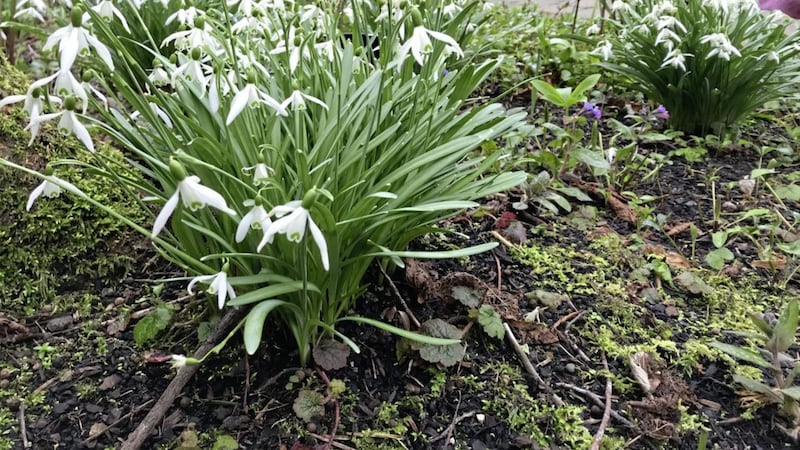WE RECENTLY put a call out to readers of The Irish News to share their gardening problems. There was a great response and while unfortunately we’re unable to answer every query, we’ve assembled a panel of experts who’ve endeavoured to find answers to some of your queries.
Q: Frank McElvanna from Armagh writes: I planted out some snowdrops ‘in the green’ in 2015. They did quite well for the first few years and flowered nicely. However, this year they have not done so well with only one or two blossoms in each clump with several green shoots but no flowers. I planted some other clumps in the same area two years ago and they are blossoming nicely.
A: A group of students studying Level 3 Horticulture at Cafre’s Greenmount campus were posed with this reader’s question and concluded: From the picture, there is quite a bit of moss in the grass which can indicate a compacted and poorly drained soil.
It also looks like the area is next to a driveway and a wall which might also indicate a more compacted soil due to construction activities. There is a tree present so there may be shade but this is generally not a problem for snowdrops as, being woodland plants, they tend to grow before the leaves are on the trees.
Snowdrops do best in a woodland or a garden border setting where there is little competition for light or nutrients in the early spring and the soil has plenty of organic matter.
Our recommendation is to lift the plants after flowering and transplant them to another part of the garden that has better soil conditions. As an alternative you could also consider lifting the bulbs and forking over the current area adding in some well-composted leaf litter to help keep the bulbs moist and improve the soil texture working, before replanting them.
Q: Angela C from Fermanagh asks: Why are so many of my older daffodils ‘blind’ – ie not producing flowers? I never tie the leaves in a knot or cut the leaves until at least eight weeks after flowering. Also last year my tulips were ‘blind’ and I fear they will be this year too.
A: Maurice Parkinson from Ballyrobert Garden and Nursery says: What you have outlined concerning your daffodils is not uncommon and there are a number of possible reasons for this condition.
The condition of the soil can be an issue and in particular some varieties do not like heavy soil and as a result the plants weaken and produce lots of smaller leaves. Additionally some varieties/types of daffodils seem to be prone to producing far too many bulbs and as a result do not reach a size which results in a flower.
Daffodils are no different to many other plants in that some varieties are simply far better than others and choice of variety is key. In our garden we have had King Alfred, Jet Fire, Carlton, Jack Snipe, and Lent Lily Daffodils amongst many other varieties for nearly 20 years and each year put on a wonderful show. Our soil is heavy, they are never fed or divided and get no special attention. In your case I suggest you lift and divide and see what happens.
As for your tulips. Is a rather similar story. Modern bred tulips in the main have a very short life and really need to be treated as an annual. I suggest you choose the older varieties. For example, Golden Oxford and Oxford are very long lived and we have a clump of the former in the garden for more than 15 years.
Q: Bernard Magennis from Rossglass, Co Down asks: Is there hope for a 55-year-old vine (variety unknown) to fruit again? It is housed in and old stone byre with the roof and one side in perspex which has now become weathered and somewhat opaque. This vine was loaded down with black grapes over the years but has only borne very few insignificant bunches in the last two years. What should I do to revive its vigour?
A: Klaus Laitenberger from Milkwood Farm says: If it is a black grape it is likely to be Black Hamburg which was commonly grown 50 years ago. I think the problem of not fruiting is a lack of light. Perspex is not ideal for plant growth. Light transmission diminishes quickly within a few years and grapes certainly need a lot of light.
A better option would have been to use polycarbonate sheeting which has much better light transmission. Also wondering about pruning – grapes need to be pruned hard in late January – I usually prune all last year's shoots back to just leave one or two buds as grapes fruit on new shoots. Another problem could have been that the winters were too mild. Grapes need a period of cold or even freezing temperatures to stimulate fruiting in the following year.
:: If you have a gardening problem you’d like addressed by our panel send it to j.manley@irishnews.com








